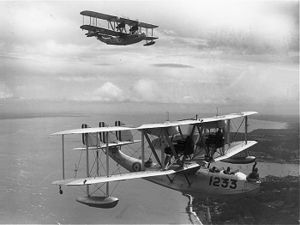Supermarine Southampton Video -
|
|
Supermarine Southampton

Role: Military reconnaissance flying boat
Manufacturer: Supermarine
First flight: 10 March 1925
Introduced: 1925
Primary users: Royal Air Force
Argentina
Australia
Japan
Turkey
Produced: 1924-1934
Number built: 83
Developed from: Supermarine Swan
Variants: Scapa
Stranraer
The Supermarine Southampton was a 1920s British flying boat, one of the most successful flying boats of the between-war period. It was a development of the Supermarine Swan, which was used for a 10 passenger service between England and France.
Design and dvelopment
The Southampton was designed by the team of R. J. Mitchell, better known as the designer of the later Spitfire. Due to the success of the Swan, the Air Ministry ordered six Southamptons direct from the drawing board, which was very unusual. As the Swan had acted in effect as a prototype, development time was short.
The Southampton was a two-engine biplane flying boat, with the tractor engines mounted between the wings. The Southampton Mk I had both its hull and its wings manufactured from wood. The Southampton Mk II had a hull with a single thickness of metal (duralumin) (the Mk I had a double wooden bottom). This change gave a weight saving of 900 lb (409 kg) allowing for an increase of range of approximately 200 mi (325 km). In 1929, 24 of the Mk I were converted by having newly-built metal hulls replacing the wooden ones. Some of the later aircraft were built with metal wings and were probably designated as Southampton Mk III. There were three positions for machine guns, one in the nose and two staggered in the rear fuselage.
The first flight of a production aircraft was made on 10 March 1925, and delivery to the RAF started in the middle of 1925.
Operational history
Southamptons first entered RAF service in August 1925. In a series of "showing the flag" flights, the type quickly became famous for long-distance formation flights; the most notable was a 43,500km (27,000 mile) expedition in 1927 and 1928. It was carried out by four Southamptons of the Far East Flight, setting out from Felixstowe via the Mediterranean and India to Singapore.
Further Southamptons were sold to a number of other countries. Eight new aircraft were sold to Argentina, with Turkey purchasing six aircraft and Australia buying two ex-RAF Mk 1 aircraft. Japan also purchased a single aircraft which was later converted into an 18 passenger cabin airliner. One RAF aircraft was loaned to Imperial Airways, with British Civil Registration G-AASH, for three-months from December 1929 to replace a crashed Short Calcultta on the airmail run between Genoa and Alexandria. In all, 83 Southamptons were constructed, excluding the three-engined Southampton MK X which was a single prototype.

Picture - RAAF Supermarine Southampton
Variants
Different powerplants were fitted in variants:
Mk I
Napier Lion V engine, wooden hull. 23 built.
Mk II
Napier Lion Va, 39 built
Argentina
Lorraine-Deitrich 12E. Five wooden hulled + three metal hulled aircraft.
Turkey
Hispano-Suiza 12Nbr. Six built..
Bristol Jupiter IX and Rolls-Royce Kestrel in experiments
Operators
Military Operators
Argentina
Argentine Navy (8)
Australia -
Royal Australian Air Force
Coastal Reconnaissance Flight RAAF
No. 1 Flying Training School's Seaplane Squadron RAAF
Japan United Kingdom
Royal Air Force
No. 201 Squadron RAF
No. 203 Squadron RAF
No. 204 Squadron RAF
No. 205 Squadron RAF
No. 209 Squadron RAF
No. 210 Squadron RAF
Civil Operators
Japan
Japan Air Transport
Nippon Kokuyuso Kenkyujo
United Kingdom
Imperial Airways
Specifications (Southampton II)
Data from Supermarine Aircraft since 1914
General characteristics
Crew: Five (2 pilots and 3 gunners)
Length: 49 ft 8½ in (15.15 m)
Wingspan: 75 ft (22.86 m)
Height: 20 ft 5 in (6.2 m)
Wing area: 1,448 ft² (134.5 m²)
Empty weight: 9,697 lb (4,398 kg)
Loaded weight: 15,200 lb (6,895 kg)
Powerplant: 2x— Napier Lion VA inline W-block, 500 hp (373 kW) each
Performance
Maximum speed: 83 kn (95 mph, 153 km/h) at sea level
Range: 473 nmi (544 mi, 876 km) at 86 mph (139 km/h) and 2,000 ft (610 m)
Endurance: 6.3 hours
Service ceiling: 5,950 ft (1,814 m)
Rate of climb: 368 ft/min (1.87 m/s)
Wing loading: 10.50 lb/ft² (51.26 kg/m²)
Power/mass: 0.066 hp/lb (0.11 kW/kg)
Climb to 6,000 ft (1,829 m) 29 minutes 42 seconds
Armament
Guns: 3 x— .303 in (7.7 mm) Lewis guns, one in bows and two amidships.
Bombs: 1,100 lb of bombs under the wings.
Related development
Supermarine Scapa
Supermarine Stranraer
Bibliography
Andrews, C.F. and E.B. Morgan. Supermarine Aircraft since 1914 (2nd edition ed.). London: Putnam, 1987. ISBN 0-85177-800-3.
A.J. Jackson, British Civil Aircraft since 1919 Volume 3, 1974, Putnam, London, ISBN 0 370 10014 X.
Thetford, Owen. Aircraft of the Royal Air Force 1918-57 (First Edition ed.). London: Putnam, 1957.
Living Warbirds: The best warbirds DVD series.
Source: WikiPedia